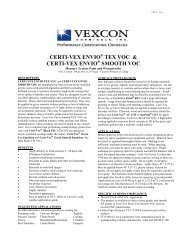Bostik® Chem-Calk® 500 - Sweeney Materials
Bostik® Chem-Calk® 500 - Sweeney Materials
Bostik® Chem-Calk® 500 - Sweeney Materials
You also want an ePaper? Increase the reach of your titles
YUMPU automatically turns print PDFs into web optimized ePapers that Google loves.
P R O D U C T D A T A<br />
Bostik® <strong>Chem</strong>-Calk ® <strong>500</strong><br />
TWO-COMPONENT, “UNI-BASE”; NON-SAG, CONSTRUCTION GRADE POLYURETHANE<br />
DATE OF LAST REVISION: 05/15/06<br />
PRODUCT<br />
Bostik® <strong>Chem</strong>-Calk ® <strong>500</strong>—A Non-Sag, Two-Component<br />
Polyurethane High Performance Elastomeric Joint Sealant.<br />
MANUFACTURER<br />
Bostik, Inc.<br />
211 Boston Street<br />
Middleton, MA 01949-2128<br />
Phone: (888) 603-8558<br />
In MA: 978-777-0100<br />
Technical Service: (800) 523-2678<br />
Technical FAX: (215) 957-0716<br />
http://www.bostik-us.com<br />
APPLICABLE STANDARDS<br />
■ TT-S-227 (Com. NBS) for two component sealants,<br />
Type II, Class A<br />
■ ASTM C920, Standard specification for elastomeric<br />
joint sealant, as Type M, Grade NS, Class 25, Use NT,<br />
A and M<br />
■ CAN/CGSB 19.24-M90<br />
PRODUCT DESCRIPTION<br />
<strong>Chem</strong>-Calk ® <strong>500</strong> is a non-sag, two-component, architectural<br />
grade, polyurethane sealant capable of dynamic joint movement<br />
totaling 50% of original joint geometry (±25%).<br />
<strong>Chem</strong>-Calk ® <strong>500</strong> polyurethane sealant has a smooth,<br />
creamy consistency that is easy to mix and gun. Its<br />
physical properties will remain stable over time and in<br />
severe weather conditions. Physical properties are<br />
relatively unchanged over a wide temperature range, -<br />
20°F to 150°F (-29°C to 66°C).<br />
Both <strong>Chem</strong>-Calk ® <strong>500</strong> and <strong>Chem</strong>-Calk ® 550 utilize the<br />
“Uni-base” System. It allows the use of all standard or<br />
custom color packs eliminating the need to determine<br />
which base is necessary.<br />
BASIC USES<br />
■ Designed for sealing expansion and control joints in<br />
precast concrete panels and metal curtain walls;<br />
perimeter sealing of door and window framing and<br />
other building components<br />
■ The sealant cures to form a durable, flexible,<br />
watertight bond with most building materials in any<br />
combination: stone, masonry, ceramics, marble,<br />
wood, steel, aluminum, and many plastics. In many<br />
cases no primer is required.<br />
■ Some substrates have variable surface characteristics<br />
depending on their source. The unpredictability of such<br />
surface characteristics makes it necessary to have a<br />
Mandatory Adhesion to Substrates Pretest (ASP) run<br />
before the job starts and at regular intervals during the<br />
job.on appropriate samples. (See ASP section.)<br />
TABLE 1: CHEM-CALK ® <strong>500</strong><br />
TYPICAL UNCURED PROPERTIES 1<br />
Property Value Test Method/Note<br />
Work Life approximately 2 hours 2 ASTM C603, Modified<br />
Shelf Life 12 months @75°F Bostik Method<br />
Flow, Sag or Slump 0.20 inch max. ASTM D2202, Modified<br />
Staining None ASTM C510<br />
Weight per Gallon 13.4 lbs. ASTM D1475<br />
1<br />
Values above are not intended to be used in specification preparation.<br />
2<br />
Relative to temperature<br />
FEATURES & BENEFITS<br />
■ Uni-base/color pack system<br />
■ Easy mix formula<br />
■ Prompt curing properties<br />
TABLE 2: CHEM-CALK ® <strong>500</strong><br />
TYPICAL CURED PROPERTIES 1<br />
(After 7 days cure at 77°F and 50% RH)<br />
Property Value Test Method/Note<br />
Hardness (Shore A) 20 ASTM D 2240<br />
Modulus@100% 65 psi ASTM D 412<br />
Tensile Strength 120 psi ASTM D 412<br />
Stain None ASTM C 510<br />
Ozone Resistance Excellent Bostik Method<br />
Joint Movement Capability +25% ASTM C 719<br />
UV Resistance Good ASTM C 793 75<br />
1<br />
Values above are not intended to be used in specification preparation.<br />
Unlimited color availability<br />
Helps reduce incomplete mixing issues<br />
Helps reduce early joint movement issues
APPLICATION LIMITATIONS<br />
■ <strong>Chem</strong>-Calk ® <strong>500</strong> sealant is not recommended for use in sealing<br />
submerged joints, particularly where porous surfaces permit water<br />
infiltration to bond surfaces.<br />
■ <strong>Chem</strong>-Calk ® <strong>500</strong> sealant is not recommended for exterior or interior<br />
structural submerged applications.<br />
■ <strong>Chem</strong>-Calk ® <strong>500</strong> sealant should not be applied with wet tooling<br />
techniques; using solvents, water or detergent/soap solutions is not<br />
recommended.<br />
■ <strong>Chem</strong>-Calk ® <strong>500</strong> sealant should not be applied to surfaces with<br />
special protective or cosmetic coatings without prior consultation with<br />
the manufacturer. Such surfaces include, but are not limited to,<br />
mirrors, reflective glass, or surfaces coated with Teflon ® , polyethylene<br />
or polypropylene.<br />
■ <strong>Chem</strong>-Calk ® <strong>500</strong> sealant should not be applied to unpredictably<br />
absorptive surfaces such as marble, limestone or granite unless a<br />
standard of appearance has been agreed on as a result of testing for<br />
stain and/or discoloration.<br />
■ <strong>Chem</strong>-Calk ® <strong>500</strong> sealant cures by chemical means. All components<br />
used can be affected by water before or during cure. The sealant<br />
should not be stored, applied or cured in areas where unusually high<br />
humidity or free water are present during the application or initial cure.<br />
■ <strong>Chem</strong>-Calk ® <strong>500</strong> non-sag sealant is not recommended for use in<br />
sealing horizontal decks, patios, driveway or terrace joints where<br />
abrasion or physical abuse is encountered. (<strong>Chem</strong>-Calk ® 550<br />
pourable or <strong>Chem</strong>-Calk ® 950 pourable is recommended for these<br />
applications.)<br />
TECHNICAL DATA<br />
<strong>Chem</strong>-Calk ® <strong>500</strong> polyurethane sealant exhibits high performance<br />
weathering characteristics against the elements. Its excellent<br />
weatherability enables it to retain its original properties after years of<br />
exposure. (See Table 2.)<br />
Joints formed with <strong>Chem</strong>-Calk ® <strong>500</strong> sealant can be expected to extend and<br />
compress a total of 50% of the installation width with no more than 25%<br />
movement in a single direction without affecting the seal or adhesive bond.<br />
(See Table 2.)<br />
INSTALLATION PROTOCOL<br />
Joint Design:<br />
More joint movement can be accommodated in a thin bead of sealant than<br />
in a thick bead. <strong>Chem</strong>-Calk ® <strong>500</strong> polyurethane sealant should be no<br />
thicker than 1/2" (12.7mm) and no thinner than 1/4" (6.4mm). In joints<br />
between 1/2" and 1", the ratio of sealant width to depth should be<br />
approximately 2:1. Sealant depth in joints between 1/4" and 1/2" should<br />
be 1/4" deep. Joints with dynamic movement should not be designed in<br />
widths less than 1/4".<br />
Principles of Joint Design:<br />
The use of a bond breaker or backer rod prevents undesirable three-sided<br />
adhesion. Two-sided adhesion typically maximizes a sealant's extension and<br />
compression capability. Polyurethane open cell or polyethylene closed cell is<br />
the recommended backup for deep joints and a a bond breaker tape is<br />
typically recommended for joints too shallow to allow a backer rod to be used.<br />
Sealants usually need be no thicker than 1/2" (12.7mm) and no thinner<br />
than 1/4" (6.4mm).<br />
Polyurethane open cell or polyethylene closed cell foam rod is the<br />
recommended backup for deep joints; polyethylene tape for joints too<br />
shallow to allow foam rod. These materials allow a bead of sealant to be<br />
applied and obtain two-sided adhesion, which will maximize a sealant's<br />
extension and compression capability.<br />
Under certain conditions, the use of closed cell type backup materials can<br />
result in bubble formation and deformation in the surface of the sealant bead.<br />
This usually does not affect the performance of the sealant, but can be<br />
unattractive. The use of open cell backup materials minimizes this condition.<br />
In remedial work where it is impossible to remove old, failed sealant and<br />
restore the surfaces to a like-new condition, the band-aid approach may be<br />
utilized. A bond-breaker tape is applied to bridge over the existing joint and<br />
old sealant so that the tape extends beyond the edges of the original joint.<br />
This also has the effect of increasing the joint width and decreasing the<br />
percentage movement that the sealant must accommodate. The technique<br />
is also useful in new construction where the designed width is determined<br />
to be inadequate for the actual movement.<br />
The longevity of on or below grade sealant installations subject to traffic or<br />
extended water immersion conditions will be less than those exposed to no<br />
traffic, intermittent water immersion or similar above grade installations.<br />
Joint Dimensions:<br />
The width of building expansion joints varies due to seasonal and daily<br />
changes in temperature. <strong>Chem</strong>-Calk ® <strong>500</strong> polyurethane sealant should be<br />
installed when the design width is approximately halfway between the<br />
dimensional extremes, typically at 65°F to 80°F.<br />
Joint width should not be less than 1/4" (6.4mm). The joint depth must<br />
allow a sealant depth, after installation of bond breaker material (backer<br />
rod/bond breaker tape), of a minimum of 1/4" (6.4mm). Lap shear joints<br />
should have a bead width equal to, or greater than twice the anticipated<br />
movement.<br />
Small curtain wall panels should allow a minimum width of 1/4" (6.4mm)<br />
for the sealant bead. Sealing of panels fabricated from plastic requires<br />
larger than usual joint dimensions due to plastic's higher coefficient of<br />
thermal expansion.<br />
A conservative design practice, which uses a portion of the sealant's<br />
movement capability as a safety factor is recommended. Sealants are<br />
subject to cohesive failure when the actual movement is greater than their<br />
rated capability. Also, sealants applied under conditions resulting in less<br />
than optimum adhesion to the joint surfaces may fail adhesively within the<br />
limits of their rated capability. For all applications requiring a high degree of<br />
dynamic movement the designed joint width should be at least four times<br />
the total anticipated joint movement<br />
Preparatory Work:<br />
Clean all joints by removing foreign matter and contaminants such as oil, dust,<br />
grease, frost, water, surface dirt, old sealants and any protective coating.<br />
Porous substrates should be cleaned as necessary by grinding, saw cutting,<br />
blast cleaning (sand or water), mechanical abrading or a combination of<br />
these methods that will be required to provide a sound, clean and dry<br />
surface for sealant application. Dust, loose particles, etc., should be blown<br />
out of joints with oil-free compressed air or vacuum cleaned.<br />
Nonporous and plastic surfaces should be cleaned by a solvent procedure<br />
or by mechanical means.<br />
Detergent or soap and water cleaning treatments<br />
are NOT recommended.<br />
Protective films must be removed by a solvent recommended by the<br />
manufacturer of the component or other means that leave no residue. In all<br />
cases where used, solvents should be applied with one clean cloth or<br />
lintless paper towel and the solvent wiped clean with a second cloth or<br />
towel. Cleaning solvents should not be allowed to air dry or evaporate<br />
without being wiped. Architectural coatings, paints and plastics should be<br />
cleaned with a solvent approved by the manufacturer of that product.<br />
Cleaning of all surfaces should be done on the same day in which the<br />
sealant is applied.<br />
CAUTION! SOLVENTS MAY BE FLAMMABLE AND ARE TOXIC.<br />
Priming:<br />
<strong>Chem</strong>-Calk ® <strong>500</strong> polyurethane weatherproofing sealant generally does not<br />
require priming for many common building materials. Joints in porous<br />
materials (concrete or wood) that are subjected to intermittent water<br />
immersion or that are weak and/or friable should be primed with Bostik<br />
Prime Coat Primer. Prime no more than you can caulk within thirty (30)<br />
minutes by the clock. Most coatings and plastics and some metals will also<br />
require priming; the selection of the appropriate primer must be done after<br />
review of the <strong>Chem</strong>-Calk ® Primer Selection Guide or after contact with<br />
Bostik Technical Service. It is important to realize that primers are intended<br />
for use only on certain substrate materials, and that the use of the wrong<br />
primer for a substrate may result in joint sealing failure. Prior to any use,<br />
however, it is always recommended that a field adhesion test be performed.<br />
See Mandatory Adhesion to Substrates Pre-test (ASP).<br />
Masking:<br />
Masking should be done after priming to avoid wicking primer under tape<br />
applied on rough surfaces or tape that is not tightly adhered to the surface.
All areas adjacent to joints can be masked to assure a neat appearance.<br />
The masking tape should not be allowed to touch the clean surfaces to<br />
which the sealant is to adhere. Soon after sealant application and before<br />
a skin forms, tooling should be completed in one continuous stroke.<br />
Remove masking tape immediately after tooling is completed.<br />
Mixing:<br />
<strong>Chem</strong>-Calk ® <strong>500</strong> is a multipart sealant provided as base, activator (or<br />
curing agent) and color pack. All the accelerator and appropriate color pack<br />
must be thoroughly mixed with the base to avoid uncured areas and/or<br />
color streaks. Failure to follow mixing instructions implicitly can result in<br />
spotty cure, random cure or complete lack of cure of the sealant. Do not<br />
attempt to mix partial units, as the exact ratio of curing agent to base is<br />
essential for optimum performance.<br />
Mixing Instructions:<br />
1. Remove the zip-top lid from the activator can and add the entire<br />
contents, scraping out all residue in the can. Add the entire contents<br />
of the accompanying Color Pack.<br />
2. Five minutes of thorough mixing is required to obtain optimum cure.<br />
Due to the critical nature of the mix, blend with a slow speed<br />
(80-150 rpm) drill for a full five minutes by the watch. Fiveminute<br />
minimum is required to properly blend the color and the<br />
activator into the sealant base. Use a timer to time your mixing.<br />
Consult Bostik Technical Services for specific mixing paddle<br />
recommendations, call 800-523-2678.<br />
The color paste should all be blended into the sealant with no<br />
streaks. The material is improperly mixed if it is not uniform in color.<br />
The color may disperse evenly in less than five minutes. Continue<br />
mixing for the five minute minimum.<br />
3. Stop at least once during mixing and scrape the bottom and sides of<br />
the container as well as the blades of the mixing paddle. Failure to<br />
follow mixing instructions implicitly can result in spotty cure, random<br />
cure or complete lack of cure.<br />
Temperature has a direct bearing on the work life and cure rate of<br />
chemically curing sealants. High temperatures result in a shortened<br />
work life and cure rate, while low temperatures extend both.<br />
Bulk caulking guns are used to install the sealant into the joints to be<br />
caulked. Special nozzle tips are available to dispense the<br />
sealant.Install backup material or joint filler as specified. Apply <strong>Chem</strong>-<br />
Calk ® <strong>500</strong> polyurethane sealant in a continuous operation using a<br />
positive pressure adequate to properly fill and seal the joint. Tool the<br />
non-sag grade sealant with adequate pressure to spread the sealant<br />
against the backup material and onto the joint surfaces. A tool with a<br />
concave profile is recommended to keep the sealant within the joint.<br />
Cleanup:<br />
Excess sealant should be dry-wiped from all surfaces while still uncured,<br />
and followed with a commercial solvent wipe. Contact Technical Service for<br />
solvent recommendations. Should sealant accidentally begin to cure on<br />
adjacent porous surfaces, the excess sealant should be allowed to progress<br />
through the initial cure or setup. It should be removed promptly by abrasion<br />
or other mechanical means. CURED SEALANT IS USUALLY VERY DIFFICULT<br />
TO REMOVE WITHOUT ALTERING OR DAMAGING THE SURFACE TO WHICH<br />
THE SEALANT HAS BEEN MISAPPLIED.<br />
Bostik recommends the use of Bostik® Hand & Tool Towels for easy<br />
removal of uncured <strong>Chem</strong>-Calk ® <strong>500</strong> from surfaces, hands and tools.<br />
MANDATORY ADHESION TO SUBSTRATES PRETEST—(ASP)<br />
A hand pull test must be run before the job<br />
starts and at regular intervals during the job.<br />
It must be run on the job site after the<br />
sealant is fully cured, usually within 7 to 21<br />
days. (Adhesion may develop fully after at<br />
least 14 days.) The hand pull test procedure<br />
is as follows:<br />
1. Make a knife cut horizontally from<br />
one side of the joint to the other.<br />
2. Make two vertical cuts approximately<br />
two inches long, at the sides of the<br />
joint, meeting the horizontal cut at the<br />
top of the two-inch cuts.<br />
3. Grasp the two-inch piece of sealant firmly between the fingers and<br />
pull down at a 90 degree angle or more, and try to pull the uncut<br />
sealant out of the joint.<br />
4. If adhesion is sufficient, the sealant should tear cohesively in itself.<br />
5. Sealant may be replaced by applying more sealant in the same<br />
manner as it was originally applied. Care should be taken to ensure<br />
that the new sealant is in contact with the original, and that the<br />
original sealant surfaces are clean, so that a proper bond between<br />
the new and old sealant will be obtained.<br />
STORAGE • PACKAGING • SHELF LIFE<br />
Shelf life of Bostik® <strong>Chem</strong>-Calk ® <strong>500</strong> must be checked prior to using the<br />
product; do not use past its shelf life. Caulk past its shelf life may not<br />
perform or adhere as described by this data sheet. High temperature<br />
and high relative humidity may reduce significantly the shelf life of<br />
polyurethane sealants. If you are unsure of the expiration date of your<br />
Bostik product, please call customer service at 1-888-603-8556 to<br />
check if the product is still within its shelf life.<br />
FOOD STATUS<br />
<strong>Chem</strong>-Calk ® <strong>500</strong> has no food status. Consult with Bostik Technical<br />
Service at 800-523-2678.<br />
COLORS<br />
<strong>Chem</strong>-Calk ® <strong>500</strong> is available in standard colors. Now there is one color<br />
pack "Uni-base" System for both <strong>Chem</strong>-Calk ® <strong>500</strong> and <strong>Chem</strong>-Calk ® 550<br />
which may be custom matched to virtually any color using the Color<br />
Pack System.<br />
Color Pack System:<br />
<strong>Chem</strong>-Calk ® <strong>500</strong> and <strong>Chem</strong>-Calk ® 550 utilize the uni-base system; color<br />
packs can be interchanged within the two products. Note: For special<br />
colors, contact Bostik Technical Service Construction Sealants Division<br />
at 800-523-2678.<br />
AVAILABILITY<br />
Available from authorized Bostik distributors. Go to www.bostik-us.com<br />
and check on our distributor locator for the closest distributor in your<br />
location or call customer service at 1-888-603-8556.<br />
HEALTH AND SAFETY<br />
Please refer to the MSDS for First Aid Information. Most current MSDS’s<br />
can be found on Bostik’s website at www.bostik-us.com or call customer<br />
service at 1-888-603-8556.<br />
TECHNICAL SERVICE<br />
TECH SERVICE phone number: 1-800-523-2678.<br />
Field visits by Bostik personnel, Bostik manufacturer representatives or<br />
Bostik authorized distributor personnel are for the purpose of making<br />
technical recommendations only and not for supervising or providing<br />
quality control on the jobsite.<br />
WARRANTY (LIMITED WARRANTY) — IMPORTANT NOTICE<br />
All statements, technical information and recommendations set forth herein<br />
are based on tests which Bostik believes to be reliable. However, Bostik<br />
does not guarantee their accuracy or completeness. The buyer and/or user<br />
should conduct its own tests of this product before use to determine proper<br />
preparation technique and suitability for proposed application. Any sales of<br />
this product shall be on terms and conditions set forth on Bostik’s order<br />
acknowledgment. Bostik warrants that the product conforms with Bostik<br />
written specifications and is free from defects at the time it leaves Bostik’s<br />
control. BOSTIK DISCLAIMS ALL OTHER WARRANTIES, EXPRESSED<br />
AND/OR IMPLIED, INCLUDING THE WARRANTIES OF MERCHANTABILITY<br />
AND FITNESS FOR A PARTICULAR PURPOSE. THE BUYER’S SOLE REMEDY<br />
FOR NONCOMPLIANCE WITH THIS WARRANTY SHALL BE FOR THE<br />
REPLACEMENT OF THE PRODUCT OR REFUND OF THE BUYER’S<br />
PURCHASE PRICE. IN NO CASE WILL BOSTIK BE LIABLE FOR DIRECT,<br />
CONSEQUENTIAL ECONOMIC OR OTHER DAMAGES.
C11



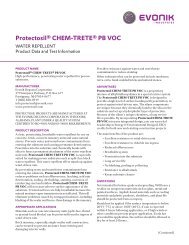
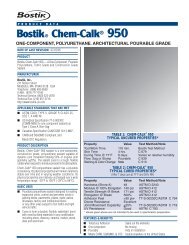
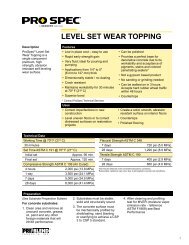
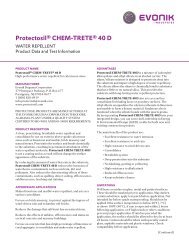
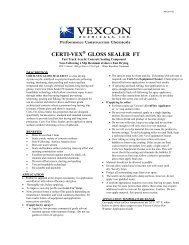
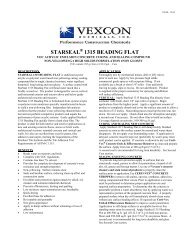
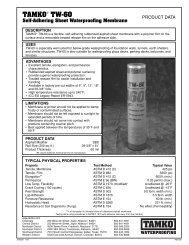
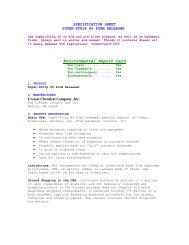
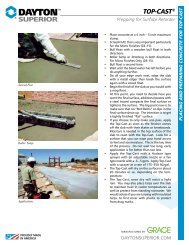
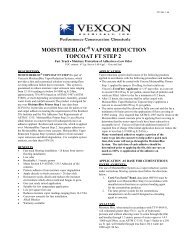
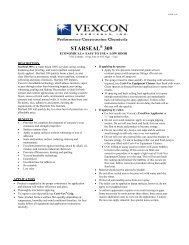
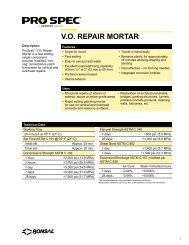
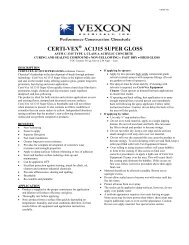
![sheets/Data sheetsVB6_Spec[1].pdf - Sweeney Materials](https://img.yumpu.com/38180404/1/190x245/sheets-data-sheetsvb6-spec1pdf-sweeney-materials.jpg?quality=85)
